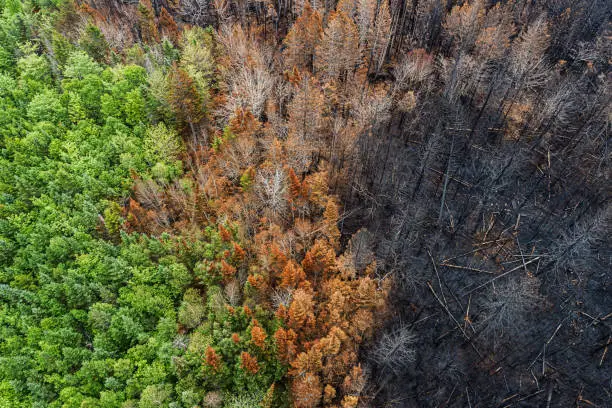Kashmir’s Climate Crisis

Hot Summers, Drier Winters, and a Changing Future

Dr Umer Iqbal
Kashmir, long celebrated as the “Paradise on Earth,” is undergoing a profound transformation as climate change disrupts its delicate ecosystem. Once renowned for its temperate weather, the region is now witnessing hotter summers, mostly drier winters, erratic rainfall, and an alarming retreat of its majestic glaciers. These shifts are not just environmental but deeply socioeconomic, threatening the livelihoods of millions dependent on agriculture, tourism, and water resources.
As the impacts of climate change intensify, Kashmir’s residents, scientists, and policymakers are grappling with a rapidly changing reality that demands urgent and coordinated action.
A recent intense warm-air advection phenomenon in South Kashmir Anantnag’s Gadool arealed to a sharp temperature rise and significant snowmelt on January 4. In response to the news, Dr. Romshoo clarified that the phenomenon is unrelated to volcanic, tectonic, or hot spring activity. Dr. Shakil Romshoo, Vice-Chancellor of Islamic University of Science and Technology (IUST) and an expert in Glaciology, Hydrology, and Climate Change posted on X (formerly Twitter), “Intense warm-air advection over parts of South Kashmir caused a rapid increase in temperature and significant snowmelt on the afternoon of January 4th. Contrary to speculations and rumours on social media, this phenomenon is unrelated to volcanic, tectonic, or hot spring activity in the region. The air-mass transformation led to a strong surface-based temperature inversion, which often contributes to dense fog. Combined with warm-air advection, usually associated with western disturbances, easterlies and other air masses, these atmospheric processes increased heat flux from the atmosphere, raising surface temperatures by an average of 10°C in a single day in some parts of South Kashmir,” Dr. Romshoo wrote.
Pertinently, the Summers in Kashmir are becoming increasingly unbearable, with temperatures soaring to unprecedented levels. The summer of 2024 was particularly alarming, as Srinagar recorded a sweltering 36.2°C in July, the highest since 1999. Such temperatures were once unimaginable in the Valley. The Valley has historically been a summer refuge from the scorching heat of the plains. But now, even Kashmir’s summers are becoming oppressive.
The average annual temperature in Kashmir has risen by approximately 0.8°C between 1980 and 2016, with a steeper rise in high-altitude areas like Pahalgam and Gulmarg, where temperatures have increased by over 1°C. This trend is mirrored across the Himalayan region, where warming is occurring at nearly twice the global average due to the region’s unique geography and elevation.
Heatwaves, once a rare phenomenon, are now regular occurrences. According to the Indian Meteorological Department (IMD), the number of heatwave days in Kashmir has doubled over the past decade. This has led to a surge in heat-related illnesses, reduced agricultural productivity, and an increased risk of wildfires.
If the summers are scorching, the winters in Kashmir are becoming eerily dry. Snowfall, a critical feature of the region’s climate and economy, has been on a steady decline. The winter of 2023-2024 was particularly stark, with snowfall levels dropping by 30% compared to the previous decade.
Snowmelt from Kashmir’s mountains is a lifeline for rivers such as the Jhelum, Chenab, and Indus, which irrigate vast tracts of agricultural land in both India and Pakistan. “When snowfall decreases, it disrupts the entire hydrological cycle,” explains Zubair Ahmad, a geographer from Pulwama.
The absence of snow has cascading effects viz water scarcity due to the reduced snowmelt threatens water availability during the critical summer months. Drier winters delay the sowing of Rabi crops, reducing yields and jeopardizing the livelihoods of thousands of farmers.
Glaciers in Kashmir, vital reservoirs of freshwater, are melting at alarming rates. A 2021 study by the Indian Space Research Organisation (ISRO) found that glaciers in the Kashmir Valley are shrinking by 0.2% annually. The Kolahoi Glacier, often referred to as the “lifeline of Kashmir,” has lost nearly 23% of its mass over the past many decades.
The consequences of glacial retreat are severe as it increases the flood risks. Increased melting during warmer months can lead to glacial lake outburst floods (GLOFs), endangering downstream communities. Kashmir’s hydropower plants, which rely on consistent water flow from glaciers, face reduced operational efficiency. The shrinking glaciers threaten the delicate alpine ecosystems that depend on cold, glacial-fed environments.
The impacts of climate change are not just environmental but deeply personal for Kashmir’s 8 million residents. Farmers, who form the backbone of the region’s economy, are struggling to adapt to unpredictable weather patterns. The health impacts of climate change are equally concerning. Rising temperatures have led to an increase in vector-borne diseases such as malaria and dengue, which were once rare in the region. Mental health issues, driven by economic stress and climate anxiety, are also on the rise.
As per the scientists, policymakers, various factors co ntribute to Kashmir’s changing climateincluding but not limited to rampant deforestation for agriculture, infrastructure, and firewood has reduced the region’s carbon-absorbing capacity. Urbanization and Global Warming has led to increased emissions and the destruction of natural habitats besides Kashmir’s unique geography makes it particularly vulnerable to global temperature increases.
Recognizing the urgency of the situation, the Jammu and Kashmir administration has launched afforestation programs and water conservation projects. The Srinagar Heat Wave Action Plan 2024-2025 includes measures such as cooling centers, tree planting drives, and public awareness campaigns. Various NGO’s are working to promote sustainable practices, including organic farming and renewable energy adoption. Local communities are leading grassroots movements to protect forests, conserve water, and adopt climate-resilient agricultural practices.
Kashmir’s climate crisis is a microcosm of the challenges facing the Himalayan region and the world at large. The stakes are high: the region’s unique biodiversity, cultural heritage, and millions of livelihoods hang in the balance.
Experts emphasize the need for a multi-pronged approach that includes building resilience through climate-smart infrastructure, crop diversification, and disaster preparedness.Reducing emissions through renewable energy, improved waste management, and reforestation. Cross-border cooperation between India and Pakistan to manage shared resources like rivers and glaciers.
“Kashmir’s future depends on our ability to act now,” says Dr. Imran. “The window for meaningful change is closing, but it’s not too late.”
As the world watches, the story of Kashmir’s climate struggle serves as both a warning and a call to action—a reminder that even the most pristine corners of the Earth are not immune to the far-reaching consequences of human-induced climate change.
Dr Umer is Editor Straight Talk Communications. He can be mailed at umeriqbalwani@gmail.com







